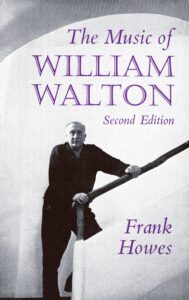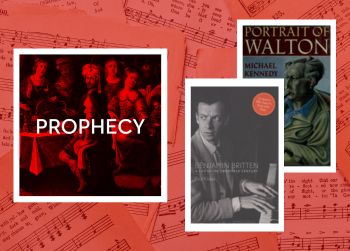Three works by British composers and a new piece by Briar Prastiti each exemplify different interpretations of the theme Prophecy at Orchestra Wellington’s concert on Saturday 5 August, the next instalment in the 2023 Inner Visions season. This blog presents a selection of materials that provide additional context and discussion about some of the music that Orchestra Wellington will perform with soloist Amalia Hall, the Orpheus Choir, baritone Benson Wilson, and the Wellington Brass Band, conducted by Orchestral Wellington’s Music Director, Marc Taddei.
Thomas Adès’s …but all shall be well is now thirty years old. The piece — which the composer said was about the end of the twentieth century, ‘our own fin-de-siècle‘ and the uncertainties of the future — was his first major orchestral work, commissioned by the Cambridge University Music Society for their 150th-anniversary concert in Ely Cathedral in 1994. The composer called it a ‘consolation for orchestra’, and its title directly evokes mystical prophecy, drawing on lines from ‘Little Gidding’, the fourth of T. S. Eliot’s Four Quartets which in turn came from Julian of Norwich’s Revelations of Divine Love.
Sin is behovely, but
All shall be well, and
All manner of things shall be well.”
Although Wellington City Library does not (yet) hold any books about Adès in its collection, Arnold Whittal’s Adès article in Grove Music (accessible through our eLibrary) summarises the composer’s biography and work. We also hold a DVD of his opera, The Exterminating Angel, and CDs of several other works, including Totentanz, Concerto for Piano and Orchestra, and Arcadiana.
William Walton’s Belshazzar’s Feast (1931) is a work with prophecy at its heart, opening with the prophet Isaiah’s words foretelling the Babylonian captivity. Later, we find ourselves at a banquet, where the Babylonian king, Belshazzar, bespoils sacred vessels stolen from the Temple at Jerusalem with his concubines and heathen lords. The idolatrous king praises false gods, while his musicians and acolytes laud him. When a strange hand writes mysterious words on the wall, the Babylonians are confused, and only Daniel — he who would survive the den of lions — can understand it. The words prophesy the fall of the city of Babylon, and shortly afterwards, King Belshazzar is dead. Although Osbert Sitwell assembled the text of Walton’s cantata from scripture and psalms, after the premiere of Belshazzar’s Feast at the 1931 Leeds Festival, Church of England authorities deemed the libretto unsuitable for performance in their cathedrals. Only in 1957 did the work appear on the programme of the Three Choirs Festival. The cantata is dramatic, eclectic in its musical style, synthesizing ‘English’ oratorio traditions encompassing the work of Handel, Mendelssohn, and Elgar, with the zest, harmonic and rhythmic invention, and jazz-age immediacy typical of Walton, who a few years earlier had scandalized critics with his music for Edith Sitwell’s Façade.
To learn more about the music and structure of Belshazzar’s Feast, and the life and work of its creator, we can offer two books about Walton:
 The music of William Walton / Howes, Frank Stewart
The music of William Walton / Howes, Frank Stewart
Frank Howes provides analysis of a number of Walton’s major, and lesser-known works, arranged by category or genre. Belshazzar’s Feast receives plenty of attention in Chapter 6, examined alongside other choral works, including the Coronation Te Deum. Howes emphasizes that Belshazzar was an especially significant work for Walton, his first excursion into a large-scale choral piece, and one that would remain popular despite its manifold complexities. Howes also considers carefully the relationship between Walton’s music and Osbert Sitwell’s text (constructed from the Book of Daniel, Revelation, and Psalms 137 and 81), in particular how Walton used chorus and narrator to heighten the characterization in the cantata.
Portrait of Walton / Kennedy, Michael
Michael Kennedy (1926-2014) wrote perceptive and sensitive biographies of a number of composers and conductors, including Adrian Boult Edward Elgar, and Richard Strauss. Kennedy’s Portrait of Walton offers an enticing study of Walton, using a rich array of primary sources to show readers Walton’s passion for his art, his many friendships, and the regard in which he was held by his peers. At the same time, Kennedy does not shy away from examining Walton’s lack of confidence in his abilities, and his tendency to envy what he saw as the achievements or preferment of his contemporaries. Kennedy also provides context and background for the genesis and performance history of works like Belshazzar’s Feast, and the book remains a valuable and readable source on Walton and his music.
Babylon : myth and reality
‘Babylon’ has become a byword for iniquity, its depiction in the Old Testament, and Renaissance art reinforcing its association with heathen excesses and debauch, but as this book – published to accompany a 2008 exhibition at the British Museum – shows, that reputation is manifestly unfair to the magnificent art and fascinating history of the fabled Mesopotamian city. Babylon: myth and reality brings ancient Babylon to life, providing a glimpse of the world in which Belshazzar’s infamous feast took place.
The work of a pacifist composer, written in the aftermath of the Spanish Civil War, and premiered by a Spanish violinist at Carnegie Hall in 1940, Benjamin Britten’s Violin Concerto is a piece that captures the tensions of a fraught, horrifying decade. Britten would later revise the Concerto, characterizing his changes to the piece as alterations that ‘leave the work as it would have been, had I been able to write in 1939 with my present experience.’ The Concerto addresses Britten’s present and the musical past, the finale’s passacaglia (a series of variations over a recurring bass) alluding to composers of the baroque era and Purcell’s mastery of the chaconne.
Britten’s unique contribution to twentieth-century music, through his songs, operas, chamber music, and concertos, as well as his establishment of Aldeburgh as a centre of British music-making, are all areas discussed by three books in the WCL collection:
Britten’s Century: celebrating 100 years of Benjamin Britten
Published in 2013 to coincide with the hundredth anniversary of Benjamin Britten’s birth, Britten’s Century is a diverse collection of essays and recollections by a variety of contributors: pianist Roger Vignoles, musicologist Philip Brett, singers Ian Bostridge and Dame Janet Baker, playwright Alan Bennett, and conductor Edward Gardner are just a few of the writers offering unique perspectives on Britten’s life and their experience of his music. Neither a biography nor an analytic study of Britten’s music, the reflections contained within Britten’s Century remind readers of Britten’s achievements as a composer and musician, without glossing over the complexities of his sometimes rebarbative personality.
The Cambridge Companion to Benjamin Britten
This 2011 addition to the Cambridge Companion series is one of the most comprehensive sources for Britten’s music. With chapters devoted to individual operas, Britten’s extensive juvenilia, his work with W. H. Auden, and the extraordinary musical world that Britten created at Aldeburgh, among others, all authored by Britten specialists, there is something in this book for anybody who is interested in Britten’s music. Eric Roseberry discusses Britten’s concertos in Chapter 16, providing some analysis of the Violin Concerto, while also considering this work in relation to the aesthetics of Britten’s other concertos. The Cambridge Companion to Britten rewards all readers, whether they are Britten enthusiasts, experts, or newcomers.
Benjamin Britten: a life in the twentieth century / Kildea, Paul Francis
Lauded as setting a new standard in composer biographies, and life-writing more generally, Paul Kildea’s 2013 biography of Benjamin Britten has been described as ‘wise, cautious,’ ‘bracingly opinionated and beautifully articulated,’ and ‘a seamless interweaving of life and music.’ More than 600 pages long, this is a densely-written study of Britten, utilizing quantities of primary sources from the pen of the subject as well as from many of his contemporaries. The result is remarkable, but also, as the author and various reviewers have noted, reminds us that Britten was no less enigmatic and unknowable a figure, both troubled and troubling, during his lifetime as he remains, half a century after his death.
Belshazzar’s Feast and Britten’s Violin Concerto both date from the 1930s, the decade which has been posited as the culmination of an English musical renaissance that began in the Victorian age, survived the ravages of the 1914-1918 War and continued to flourish for another twenty years. The parameters and chronology of this ‘renaissance’ have been much debated by musicologists and cultural theorists, some of the controversy stoked by this book:
The English musical renaissance, 1840-1940: constructing a national music / Hughes, Meirion
First published (with Robert Stradling) in 1993 as The English Musical Renaissance: Construction and Deconstruction, a book with a provocative thesis that proved disputatious among musicians and scholars: namely, that the nineteenth-century rebirth of English music was not the result of composers shaking off the hegemonic weight of their continental neighbours and turning to received traditions, but was instead part of a resurgence in overt nationalism, spearheaded by a small coterie at the Royal College of Music. In 2001, with the present revised title, Meirion Hughes also revised and expanded some of the contentions made in 1993, looking in more detail at what came to be perceived as ‘Englishness’ in music, whose music became canonical (and whose didn’t), and the philosophy and aesthetics that lay behind these value judgments, up until the 1940s. This book offers, therefore, valuable cultural, political, and social context for the environment in which William Walton and Benjamin Britten came of age as composers.


